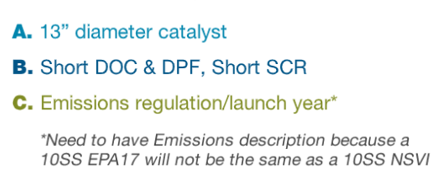- What is a TLA?
- TLA stands for Top-Level-Assembly. This is the aggregation of welded components into an assembly on which removable components like sensors, dosing valve, access panels, v-band clamps are installed.
- What do the sizes / nomenclature mean?
- Does CES create custom Aftertreatment solutions for each application?
- CES’ strategy for product development is horizontal leveraging where a base product can be tailored to meet individual customer’s need. This allows for managed proliferation across markets market varying populations.
- Will a muffler be needed?
- Mufflers are not typically needed. The aftertreatment provides a level of acoustic attenuation that generally allows OEMs to meet drive by noise requirements without engineered components. There have been issues in the passed and it’s a key item that is evaluated during a new product launch.
- Does your system require air?
- The CES dosing systems function without the need for compressed air.
- What orientations can the Aftertreatment be installed?
- Single modules come in two varieties, horizontal and vertical and they must be mounted in the respective orientation
- What is regeneration and how often does it occur?
- Regeneration is a process used to remove Carbon (C) build up from the DPF catalyst. This process occurs on a regular frequency that varies based on system and application. For example a 2007 system might have regenerated every 12-24 hrs whereas our 2017 systems might make it >100hrs before requiring a regeneration. This is due to better engine tuning and DPF catalyst technology improvements. We don’t publish our regen intervals, but fleet maintenance supervisors can find regeneration frequency information in Insite.
- How are customers benefiting from the Single Module™ system?
- Advancements in catalyst technology and packaging have allowed us to reduce the weight of our aftertreatment offering by up to 40 percent. On average, customers driving midrange engines are seeing a 40lb weight reduction. Heavy-duty engine customers are seeing an average of a 60lb weigh reduction, with some customers seeing up to a 100lb weight reduction. Given that a weight reduction of 25lbs can make a tangible difference for the drivers, we’re giving them more opportunity to carry more fuel or more freight. We also have some customers, like those in the vocational market, who are seeing true benefits from the compact packaging design. With more space available behind the cab, customers have more flexibility for more axels, which directly impacts their ability to carry more freight.
- How does reducing the weight of the system impact the performance?
- Advancements in catalyst technology and packaging have allowed us to reduce the weight of our aftertreatment offering by up to 40 percent. On average, customers driving midrange engines are seeing a 40lb weight reduction. Heavy-duty engine customers are seeing an average of a 60lb weigh reduction, with some customers seeing up to a 100lb weight reduction. Given that a weight reduction of 25lbs can make a tangible difference for the drivers, we’re giving them more opportunity to carry more fuel or more freight. We also have some customers, like those in the vocational market, who are seeing true benefits from the compact packaging design. With more space available behind the cab, customers have more flexibility for more axels, which directly impacts their ability to carry more freight.
- Customers want a maintenance-free system. Does the Single Module still require Diesel Particulate Filter (DPF) cleaning?
- Advancements in DPF catalyst technologies have allowed us to implement a smaller filter while also improving ash capacity over previous systems we’ve offered. The Single Module allows many customers to go further without having to service their DPFs, often as much as twice as far as they used to go. However, the DPF is not a service-free system and will eventually require attention.
- The Single module system is so much smaller - does that mean I will use less DEF?
- The new Single Module represents a major leap forward in aftertreatment technology – we have talked previously about much easier integration as it takes up to 40% less space and weighs 20% less than its predecessor. But equally significant is the much lower maintenance that the Single Module brings –we have moved our DPF cleaning interval out to an amazing 600,000 to 800,000 miles. That’s practically maintenance free for many owners and much further than everyone else in the industry
- What is the maintenance interval of the single module system?
- Advancements in catalyst technologies have enabled our DPF to have a bigger ash capacity, allowing for increased cleaning and maintenance intervals. The cleaning required is heavily dependent on the application and duty-cycle.
- How does a Diesel Particulate Filter work?
- A diesel particulate filter, or DPF, is comprised of a wall-flow substrates typically made of porous ceramic media that capture exhaust gas and remove PM or soot particles. A typical filter consists of an array of small channels for exhaust gas to flow. Adjacent channels are plugged at opposite ends, forcing the exhaust gas to flow through the porous wall, capturing the soot particles on the surface and inside pores of the media. As soot accumulates in the filter, a regeneration event will provide sufficient heat to oxidize and capture the soot. The remaining ash can be removed during regularly scheduled cleaning events based on the recommendations of the engine manufacturer.
- When was the UL2 launched?
- UL2 launched in NA markets in 2013 and in 2014 in European markets produced in Germany. CMI launched UL2 for Off-Highway & High-Horsepower in 2014 and in 2017 for On highway in the NA markets across all engines and customers. For this purpose a new production location in Juarez Mexico was established.
- Why can’t the doser dose vertically upward (against gravity)?
- The UL2 dosing systems have a very fine spray pattern with small droplet sizes. Dosing vertically upward (against gravity) is not recommended because of higher DEF deposits and DEF crystallization risk at point of DEF injection.
- What is the difference between SU, DU, Dosing valve, dosing injector, pump, doser?
- SU= Supply Unit = pump. This is the unit providing pressurized DEF to the doser on the SCR from the tank.
- DU= Dosing Unit = Dosing valve = dosing injector = doser. This is mounted on the SCR
- Dosers can be unreliable due to frost - how is your product different?
- UL2 are the only liquid-only dosing systems in the market offering freeze-robustness in their design, and improved reliability, as urea is continually present within the unit to prevent dosers crystallization and clogging. It offers automatic depressurization at system shutdown, adding proven reliability in freeze resistance
- What are the advantages of having a freeze robust system?
- It eliminates the need for power after key-off, providing freeze-robustness. Offers quicker dosing readiness at key-on; avoids priming issues with pump, as no purging is necessary. Quicker NOx treatment and prevention of crystallization, as urea is always present in system. Prevents system damage during intentional or unintentional interruption of power to the vehicle
- What are the dosing rates for the UL2?
- The UL2 urea dosing system is the only liquid-only dosing system that is capable of meeting high flow dosing rates of up to 20.5 kg/hr.
- Off-highway
- On-highway
- Resources
- Solutions
- Applications
- Industries
- Resources
- Sales and Service
- Parts
- Manuals and Technical Documents
Aftertreatment FAQ
Aftertreatment FAQ
Redirecting to
cummins.com
The information you are looking for is on
cummins.com
We are launching that site for you now.
Thank you.


